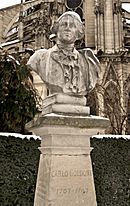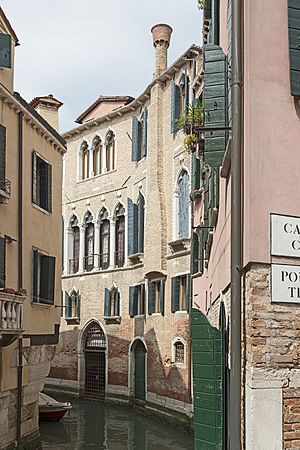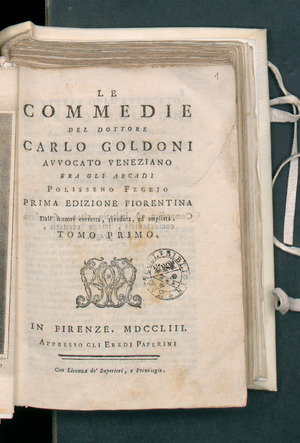Carlo Goldoni facts for kids
Quick facts for kids
Carlo Goldoni
|
|
|---|---|

Goldoni c. 1757
|
|
| Born | Carlo Osvaldo Goldoni 25 February 1707 Venice, Republic of Venice (present-day Italy) |
| Died | 6 February 1793 (aged 85) Paris, France |
| Pen name | Polisseno Fegeio, Pastor Arcade |
| Occupation |
|
| Genre | Comedy |
| Notable works |
|
| Spouse | Nicoletta Conio |
Carlo Osvaldo Goldoni (born February 25, 1707 – died February 6, 1793) was a famous Italian playwright and writer of opera stories from the Republic of Venice. He wrote some of Italy's most popular and loved plays. People enjoyed his plays because they were clever and honest. His plays often showed what life was like for the growing middle class, including their values and problems. Goldoni wrote in French and Italian, but he also used the Venetian language and local sayings in his plays. He sometimes used the pen name Polisseno Fegeio, Pastor Arcade.
Contents
Who Was Carlo Goldoni?
Carlo Goldoni wrote many plays that changed Italian theatre. He is known for making comedies more realistic and less about masks and improv. He wanted plays to show real life and people's everyday actions.
Goldoni's Early Life
Carlo Goldoni was born in Venice in 1707. His parents were Margherita Salvioni and Giulio Goldoni. From a very young age, Carlo loved theatre. He played with puppets and read plays instead of other books.
His father wanted him to study law. Carlo even went to a strict school in Pavia, but he spent a lot of time reading Greek and Latin comedies. He got into trouble for writing a silly poem about some girls in Pavia and had to leave the school in 1725. He continued to study law and eventually got his degree. He worked as a law clerk for a while.
In 1731, his father passed away. In 1732, Carlo left his hometown to avoid a marriage he didn't want. He met a theatre manager named Giuseppe Imer in Verona. Imer helped him start his career as a comedy writer. Carlo also met his future wife, Nicoletta Conio, there. They returned to Venice, where he lived until 1743.
Becoming a Playwright

Goldoni's first play was a tragedy called Amalasunta, performed in Milan. It was not successful. A theatre director told him that Italian plays needed to please the actors and musicians, not just follow old rules. Goldoni was so disappointed that he burned his play!
His next play, Belisario, written in 1734, was more successful. He also wrote stories for opera seria (serious operas) and worked as a literary director for a famous opera house in Venice.
Goldoni soon realized he was better at writing comedies. He wanted to improve the Italian stage. He looked up to the French playwright Molière as his role model. In 1738, he wrote his first real comedy, L'uomo di mondo ("The Man of the World"). He worked for different theatre managers and wrote many of his best plays during this time in Venice. By 1743, he had developed his unique style. This style mixed ideas from Molière with the fun of Commedia dell'arte (a type of improvised comedy) and his own clever ideas. La Donna di garbo was the first Italian comedy written in this new way.

After 1748, Goldoni worked with the composer Baldassare Galuppi. They created many 'opera buffa' (funny operas). Galuppi wrote music for more than twenty of Goldoni's stories. These operas also blended elements of Commedia dell'arte with real-life situations and middle-class characters. Two of their most famous musical comedies were Il filosofo di campagna (The Country Philosopher) in 1752 and La buona figliuola (The Good Girl) in 1760.
In 1753, Goldoni moved to another theatre in Venice, the Teatro San Luca, where he put on most of his plays until 1762.
Moving to France

In 1757, Goldoni had a big disagreement with another playwright, Carlo Gozzi. This made him very unhappy with Italian audiences. So, in 1761, he moved to Paris, France. He got a job at the French court and was in charge of the Théâtre-Italien. He spent the rest of his life in France, writing most of his plays in French and writing his life story (memoirs) in French too.
One of his most successful plays in French was Le bourru bienfaisant. It was dedicated to Marie Adélaïde, a daughter of King Louis XV. Goldoni was quite popular in France. In 1769, when he retired, the King gave him a pension (regular payment). He lost this pension after the French Revolution. Sadly, the government voted to give him his pension back the day after he died. They gave it to his wife instead, because she was old and poor.
Goldoni's Big Ideas
In his memoirs, Goldoni talked a lot about how Italian comedy was when he started writing. It mostly involved Commedia dell'arte, which was a type of comedy where actors improvised (made up) their lines using traditional masks and characters. Goldoni wanted to change this. He aimed to show real life and manners through his characters and their actions, instead of just using old masks and plots. He believed that Italian life could be shown in a new, artistic way.
Goldoni's plays helped bring about a big change in theatre that others had tried but not fully achieved. He said he used Molière's plays as his inspiration. Whenever one of his own plays did well, he would tell himself, "Good, but not yet Molière." Goldoni's plays are generally kinder and more hopeful than Molière's.
However, his success also led to strong criticism from Carlo Gozzi. Gozzi said that Goldoni had taken away the magic and imagination from Italian theatre. Gozzi's popular fairy tale plays made Goldoni so annoyed that he decided to move to France.
Goldoni gave Italy a classic style of comedy that has been copied by others, but never quite matched by another master.
What Languages Did He Use?
In Goldoni's Italian comedies, characters originally spoke either the formal Tuscan language (which became modern Italian) or the Venetian dialect. The language they spoke depended on their social class. However, in some printed versions of his plays, he changed the Venetian parts into Tuscan as well.
Selected Works
Here are a few examples of Goldoni's many plays:
Tragedies
- Rosmonda (1734)
- Griselda (1734)
Tragicomedies
- Belisario (1734)
- Don Giovanni Tenorio o sia Il dissoluto, "The Dissolute" (1735)
Comedies
- Il servitore di due padroni, (1745) "The Servant of Two Masters"
- I due gemelli veneziani, "The Two Venetian Twins" (1747)
- La vedova scaltra, "The Shrewd Widow" (1748)
- La putta onorata, "The Honorable Maid" (1749)
- Il bugiardo, "The Liar" (1750–1751)
- La locandiera, "The Mistress of the Inn" (1751)
- I rusteghi, "The Boors" (1760)
- Le baruffe chiozzotte, "The Chioggia Scuffles" (1762)
Opera Buffa Libretti
(These are the stories for funny operas)
- Il mondo della luna (The World on the Moon), set to music by Galuppi (1750), Haydn (1777), and others.
- Il filosofo di campagna (The Country Philosopher) by Galuppi (1754)
- La buona figliuola (The Good Girl) by Niccolò Piccinni (1760)
- Lo speziale (The Apothecary) by Joseph Haydn (1768)
Books
- Mémoires, "Memoirs". Paris (1787) - This is his autobiography.
See also
 In Spanish: Carlo Goldoni para niños
In Spanish: Carlo Goldoni para niños



